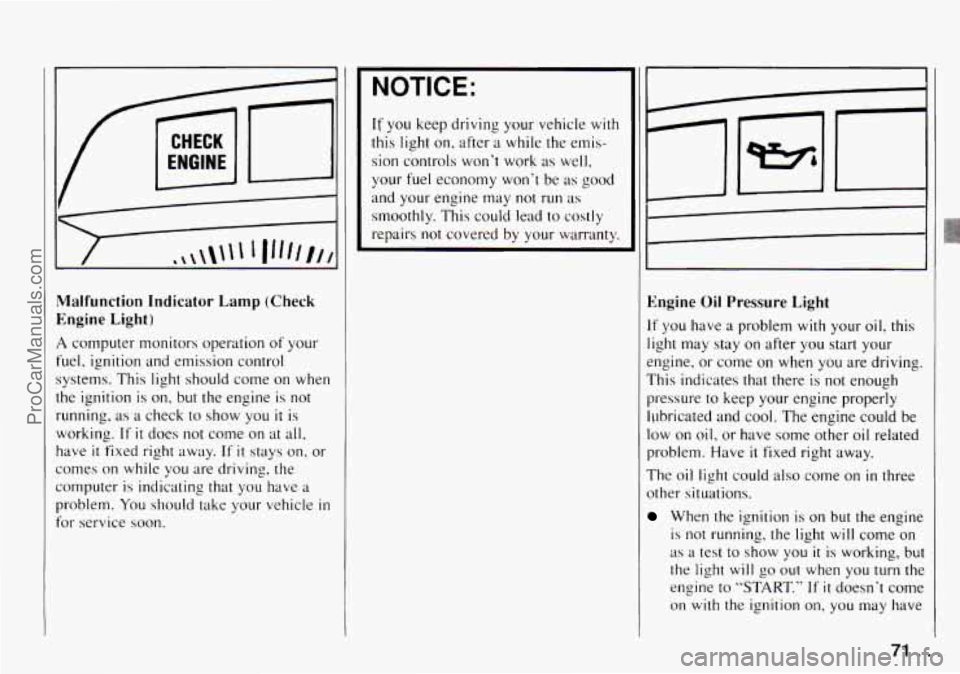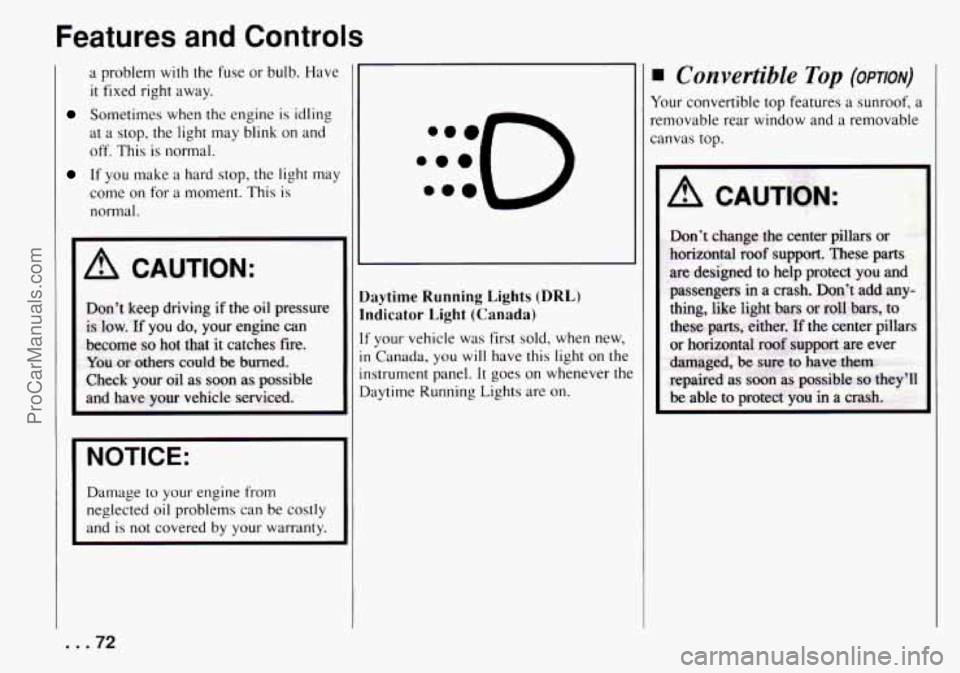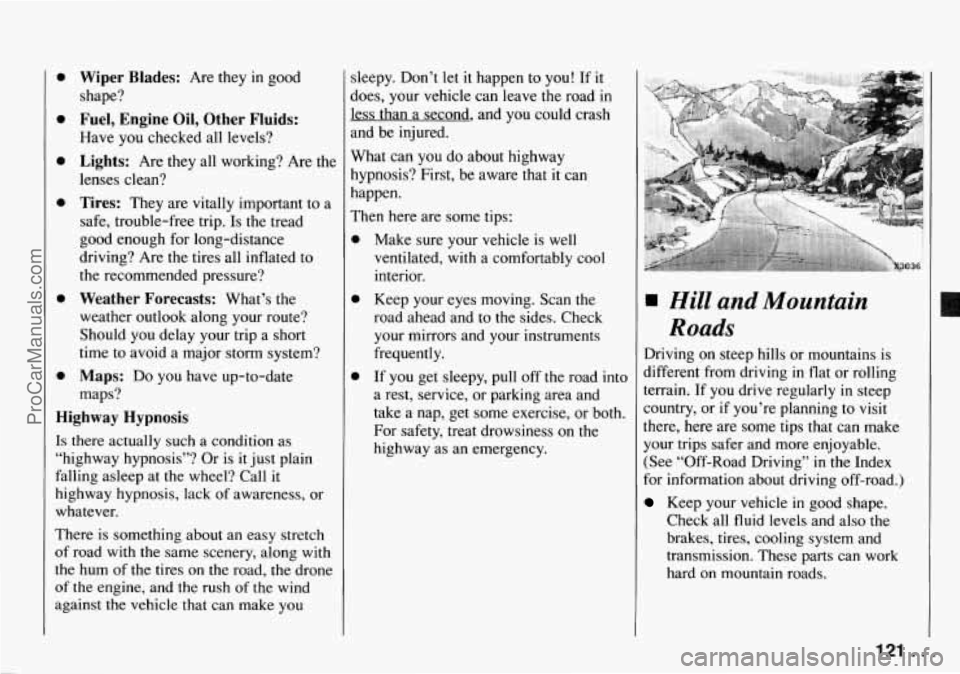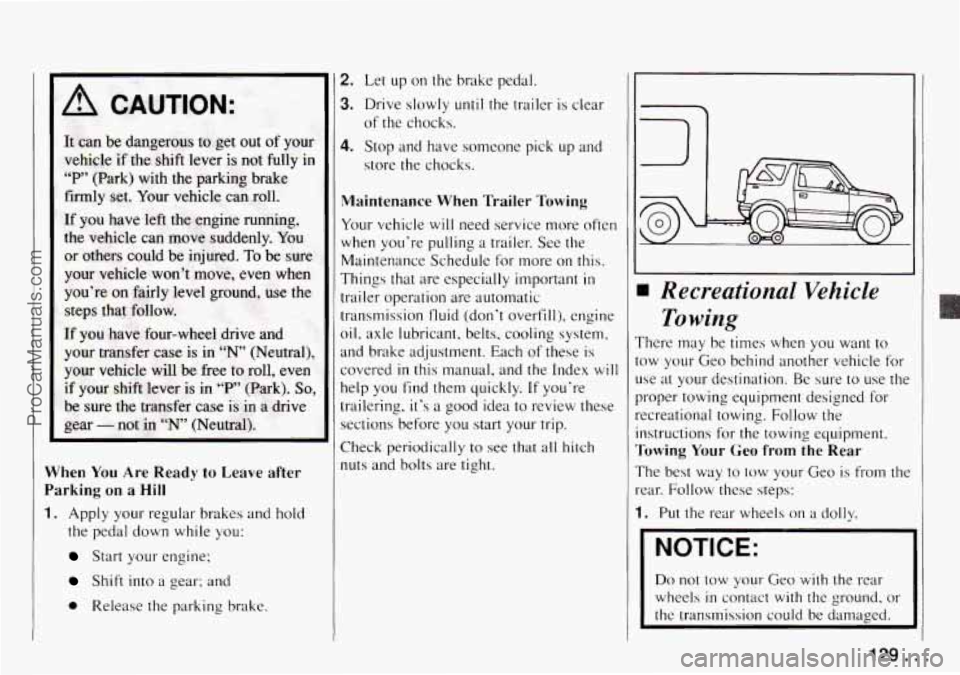check engine CHEVROLET TRACKER 1994 Owners Manual
[x] Cancel search | Manufacturer: CHEVROLET, Model Year: 1994, Model line: TRACKER, Model: CHEVROLET TRACKER 1994Pages: 258, PDF Size: 14.43 MB
Page 42 of 258

NOTICE:
Holding your key in “START” for
longer than 15 seconds at a time will
cause your battery to be drained
much sooner. And the excessive heat
can damage your starter motor.
2. If it doesn’t start right away, hold
your key
in “ START” for about three
seconds at a time until your engine
starts. Wait about 15 seconds between
each
try to help avoid draining your
battery.
If your engine still won’t start, call your
dealer for help.
NOTICE:
Your engine is designed to work with
the electronics in your vehicle. If you
add electrical parts or accessories,
you could change the way
the fuel
injection system operates. Before
adding electrical equipment, check
with your dealer. If you don’t, your
engine might not perform properly.
If you ever have to have your vehicle
towed, see the part of this manual
that tells how to do
it without damag-
ing your vehicle. See “Towing Your
Vehicle” in the Index.
)riving through Deep Standing
Water Engine Coolant Heater (Engine
Block Heatel‘) (CANADA)
In very
cold weather, 0 OF (- 1 8 O C) or
colder, the engine coolant heater can help.
You’ll get easier starting and better fuel
economy during engine warm-up.
Usually, the coolant heater should be
plugged in a minimum
of four hours
prior to starting your vehicle.
To use the coolant heater:
1. Turn off the engine.
2. Open the hood and unwrap the
electrical cord.
3. Plug it into a normal, grounded
110-volt outlet.
NOTICE:
If you drive too quickly through deep
puddles
or standing water, water can
come in through your engine’s air
intake and badly damage your
engine.
If you can’t avoid deep
puddles or standing water, drive
through them very slowly.
41 ..
ProCarManuals.com
Page 69 of 258

Features and Controls
Tachometer
The tachometer shows engine speed in
thousands of revolutions per minute
(rpm).
You can use it while driving to
select correct shift points. The tachometel
may not return to zero when the engine
is
not running.
NOTICE:
Do not operate the engine with the
tachometer in
the red area, or engine
damage may occur.
r
I:
!
1
1
1
... 68
and Indicators
This section describes the warning lights
and gages that may be on your vehicle.
The pictures will help you locate them.
Warning lights and gages can signal that
something
is wrong before it becomes
serious enough to cause
an expensive
repair or replacement. Paying attention to
your warning lights and gages could also
save you or others from injury.
Warning lights go
on when there may be
or is a problem with one
of your vehicle’s
functions.
As you will see in the details
on the next few pages, some warning
lights come
on briefly when you turn the
ignition key just to let you know they’re
working. If you are familiar with this
section, you should not be alarmed when
this happens.
Gages can indicate when there may be or
is a problem with one of your vehicle’s
functions. Often gages and warning lights
work together to
let you know when
there’s a problem with your vehicle.
When one of the warning lights comes
on
and stays on when you are driving, or
when one
of the gages shows there may be
a problem, check the section that
tells
you what to do about it. Please follow the
manual’s advice. Waiting to
do repairs
can be costly
- and even dangerous. So
please get to know your warning lights
and gages. They’re a big help.
ProCarManuals.com
Page 71 of 258

Features and Controls
If the light comes on while you are
driving,
pull off the road and stop
carefully. You may notice that the pedal is
harder
to push. Or, the pedal may go
closer to the floor. It may take longer to
stop. If the light is still on. have the
vehicle towed for service. (See “Towing
Your Vehicle“
in the Index.)
p CAUTION:
Your brake system may not be work-
ing properly if the brake system
warning light is on, Driving with the
brake system warning light on can
lead
to an accident. If the light is still
on after you’ve pulled off the road
and stopped carefully, have the
vehicle towed
for service.
The brake system warning light will also
come
on when you set your parking
brake, and
it will stay on if your parking
brake doesn’t release
fully. If it stays on
after your parking brake is fully released.
it means you have a brake problem.
‘ngine Coolant Temperature Gage
rhis gage shows the engine coolanl
emperature.
If the gage pointer moves to
he
”H” (red) side. your engine is too hot!
t means that your engine coolant has
)verheatcd and you should
stop your
ehicle and
turn off the engine HS soo~
Iossible.
1 as
HOT COOLANT CAN BURN YOU
BADLY!
In “Problems on the Road.” this manual
shows what to do. See ”Engine
Overheating”
in the Index.
Charging System Light
This light will come on briefly when you
turn on the ignition, but the engine is not
running, as
a check to show you it is
working. Then
it should go out when the
engine starts. If it stays on or comes on
while you are driving, you may have a
problem with the electrical charging
system.
It could indicate that you have a
loose generator drive
belt or another
electrical problem. Have
it checked right
away. Driving while this light is on could
drain
your battery.
If you must drive a short distance with
this light on,
be certain to turn off all your
accessories. such as
the radio and air
conditioner.
. . .70
ProCarManuals.com
Page 72 of 258

I1 1
Malfunction Indicator Lamp (Check
Engine Light)
A computer monitors operation of your
fuel, ignition and emission control
1 systems. This light should come on when
the ignition is
on, but the engine is not
running, as a check to show you it is
working.
If it does not come on at all,
have it fixed right away. If it stays on. or
comes on while
you are driving, the
computer
is indicating that you have a
problem.
You should take your vehicle in
for service soon.
NOTICE:
If you keep driving your vehicle with
this light on. after
a while the ernis-
sion controls won't work as well,
your
fuel economy won't be as good
and your engine may
not run as
smoothly. This could lead to costly
repairs
not covered by your warranty.
Engine Oil Pressure Light
If you have a problem with your oil? this
light may stay
on after you start your
engine, or come
on when you are driving.
This indicates that there is not enough
pressure
to keep your engine properly
ILJbricated and
cool. The engine could be
low on oil, or have some other oil related
problem. Have
it fixed right away.
The oil light could also come
on in three
other situations.
When the ignition is on but the engine
is not running, the light will come on
as a test to show you it is working, but
the light will
go out when you turn the
engine to
"START." If it doesn't come
on with the ignition
on, you may have
71
ProCarManuals.com
Page 73 of 258

Features and Controls
a problem with the fuse or bulb. Have
it fixed right away.
Sometimes when the engine is idling
at a stop, the light may blink on and
off. This is normal.
If you make a hard stop, the light may
come on for a moment. This is
normal.
A CAUTION:
Don't keep driving if the oil pressure
is low, If' you do, your engine can
be~ome so hot that it catches fae.
You UT ol;krers could be burned.
Check your oil as SQOD as possible
and have yaw vehicle serviced.
NOTICE:
Damage to your engine from
neglected oil problems can be costly
and is not covered by your warranty.
laytime Running Lights (DRL)
ndicator Light (Canada)
F your vehicle was first sold, when new,
I Canada, you will have this light on the
xtrument panel.
It goes on whenever the
laytime Running Lights are on.
Convertible Top (OPTION)
Your convertible top features a sunroof, a
removable rear window and a removable
canvas top.
A CAlJTtON:
... 72
ProCarManuals.com
Page 88 of 258

Ventilation Tips
0
0
0
Keep the hood and front air inlet free
of ice, snow, or any other obstruction
(such as leaves). The heater and
defroster will work far better, reducing
the chance of fogging the inside of
your windows.
When you enter a vehicle in cold
weather, move the fan lever towards
for a few moments before driving off.
This helps clear the intake ducts of
snow and moisture, and reduces the
chance of fogging the inside of your
windows.
Keep the air path under the front seats
clear of objects. This helps air to
circulate throughout your vehicle.
Audio Systems
Your Delco@ audio system has been
designed to operate easily and give years
of listening pleasure. But you will get the
most enjoyment out of
it if you acquaint
yourself with it first. Find out what your
Delco@ system can do and how to operate
all its controls, to be sure you’re getting
the most out of the advanced engineering
that went into
it.
NOTICE:
Before you add any sound equipment
to your vehicle - like a tape player,
CB radio, mobile telephone or
two-way radio
- be sure you can
add what you want.
If you can, it’s
very important to do it properly.
Added sound equipment may inter-
fere
with the operation of your
vehicle’s engine, Delco8 radio or
other systems, and even damage
them. And, your vehicle’s systems
may interfere with the operation of
sound equipment that has been added
improperly.
So, before adding sound equipment,
check with your dealer and be sure
to
check Federal rules covering mobile
radio and telephone units.
87 ...
ProCarManuals.com
Page 117 of 258

Your Driving and the Road
long as your tailpipe is under water, you'll
never be able to
start your engine. When
you go through water, remember that
when your brakes get wet, it may take
you longer to stop.
After Off-Road Driving
Remove any brush or debris that has
collected
on the underbody, chassis or
under the hood. These accumulations can
be a fire hazard.
After operation in mud or sand, have the
brake linings cleaned and checked. These
substances can cause glazing and uneven
braking. Check the body structure,
steering, suspension, wheels, tires, and exhaust system
for damage.
Also, check
the fuel lines and cooling system for any
leakage.
Your vehicle will require more frequent
service due to off-road
use. Refer to the
Maintenance Schedule for additional
information.
4 Driving at Night
Night driving is more dangerous than day
driving. One reason is that some drivers
are likely
to be impaired - by alcohol or
drugs, with night vision problems, or by
fatigue.
Here are some tips on night driving.
Drive defensively.
Don't drink and drive.
Adjust your inside rearview mirror to
reduce the glare from headlights
behind you.
Since you can't see as well,
you may
need to slow down and keep more space between
you and other vehicles.
. . .116
ProCarManuals.com
Page 122 of 258

0
0
Wiper Blades: Are they in good
shape?
Fuel, Engine Oil, Other Fluids:
Have you checked all levels?
Lights: Are they all working? Are the
lenses clean?
Tires: They are vitally important to a
safe, trouble-free trip. Is the tread
good enough for long-distance
driving? Are the tires all inflated to
the recommended pressure?
Weather Forecasts: What’s the
weather outlook along your route?
Should you delay your trip a short
time to avoid a major storm system?
Maps: Do you have up-to-date
maps?
Highway Hypnosis
Is there actually such a condition as
“highway hypnosis”? Or is it just plain
falling asleep at the wheel? Call
it
highway hypnosis, lack of awareness, or
whatever.
There is something about an easy stretch
of road with
the same scenery, along with
the hum of the tires
on the road, the drone
of the engine, and the rush of the wind
against the vehicle that can make you sleepy. Don’t let it happen
to you! If it
does, your vehicle can leave the road in
less than a second, and
you could crash
and be injured.
What can you do about highway
hypnosis? First, be aware that
it can
happen.
Then here are some tips:
0 Make sure your vehicle is well
ventilated, with a comfortably cool
interior.
0 Keep your eyes moving. Scan the
road ahead and to
the sides. Check
your mirrors and your instruments
frequently.
0 If you get sleepy, pull off the road into
a rest, service, or parking area and
take a nap, get some exercise,
or both.
For safety, treat drowsiness on the
highway as an emergency.
Hill and Mountain
Roads
Driving on steep hills or mountains is
different from driving
in flat or rolling
terrain. If you drive regularly in steep
country, or
if you’re planning to visit
there, here are some tips that can make
your trips safer and more enjoyable.
(See “Off-Road Driving” in the Index
for information about driving off-road.)
Keep your vehicle in good shape.
Check all fluid levels and also the
brakes, tires, cooling system and
transmission. These parts can work
hard
on mountain roads.
ILI . . .
ProCarManuals.com
Page 129 of 258

Your Driving and the Road
passed vehicle before vou can return to
your lane.
Backing Up
Hold the bottom of the steering wheel
with one hand. Then, to move the trailer
to the left, just move that hand to the left.
To move
the trailer to the right, move
your hand to the right. Always back up
slowly and,
if possible, have someone
guide you.
Making Turns
When you’re turning with a trailer, make
wider turns than normal.
Do this so your
trailer won’t strike soft shoulders, curbs,
road signs, trees, or other objects. Avoid
jerky or sudden maneuvers. Signal well
in
advance.
Turn Signals When Towing a Trailer
When you tow a trailer, your vehicle has
to have a different turn signal flasher and
extra wiring. The green arrows on your
instrument panel will flash whenever you
signal a turn or lane change. Properly
hooked up, the trailer lights will also
flash, telling other drivers you’re about to
turn, change lanes or stop. When towing
a trailer, the green arrows
on your instrument panel will flash for
turns even
if the bulbs on the trailer are
burned out. Thus, you may think drivers
behind you are seeing your signal when
they are not. It’s important to check
occasionally to be sure the trailer bulbs
are still working.
Driving on Grades
Reduce speed and shift to a lower gear
before you start down a long or steep
downgrade. If you don’t shift down, you
might have to use your brakes
so much
that they would get hot and no longer
work well.
On a long uphill grade, shift down and
reduce your speed to around
45 mph
(70 km/h) to reduce the possibility of
engine and transmission overheating.
If
you are towing a trailer and you have
a manual transmission with fifth gear,
you may prefer not
to use fifth gear. Just
drive in fourth gear (or, as
you need to,
.a lower gear).
Parking on Hills
You really should not park your vehicle,
with a trailer attached, on a hill. If
something goes wrong, your
rig could start
to move. People can be injured, and
both your vehicle and the trailer can be
damaged.
But if you ever have to park
your rig on a
hill, here’s how to do it:
1. Apply your regular brakes, but don’t
shift into
“F’” (Park) yet, or into gear
for a manual transmission.
2. Have someone place chocks under the
3. When the wheel chocks are in place,
release the regular brakes until the
chocks absorb the load.
trailer wheels.
4. Reapply the regular brakes.
Then
apply your parking brake, and then
shift to
‘T” (Park), or “R” (Reverse)
for a manual transmission.
5. If you have a four-wheel-drive
vehicle, be sure the transfer case is
in
a drive gear - not in “N” (Neutral).
6. Release the regular brakes.
. .-’ . 1 28
ProCarManuals.com
Page 130 of 258

When You Are Ready to Leave after
Parking
on a Hill
1. Apply your regular brakes and hold
the pedal down while you:
Start your engine;
Shift into a gear; and
0 Release the parking brake.
2. Let up on the brake pedal.
3. Drive slowly until the trailer is clear
4. Stop and have someone pick up and
of the chocks.
store the chocks.
Maintenance When Trailer Towing
Your vehicle will need service more often
when you're pulling
a trailer. See the
Maintenance Schedule for more
on this.
rhings that are especially important in
:railer operation are automatic
.ransmission lluid (don't overfill), engine
oil? axle lubricant, belts, cooling system,
and brake adjustment. Each of these
is
covered in this manual, and the Index will
help you find them quickly. If you're
trailering, it's a good idea to review these
sections before you start
your trip.
Check periodically
to see that all hitch
nuts and bolts are tight.
I
I
Recreational Vehicle
To wing
There may be times when you want to
:ow your Geo behind another vehicle for
Jse at your destination. Be sure to use the
proper towing equipment designed for
-ecreational towing. Follow the Instructions for the towing equipment.
rowing Your Geo from the Rear
rhe best way to tow your Geo is from the
-ear. Follow these steps:
1. Put the rear wheels on a dolly.
I NOTICE:
I
Do not tow your Geo with the rear
wheels
in contact with the ground. or
the transmission could be damaged. 1
.. 129. ProCarManuals.com